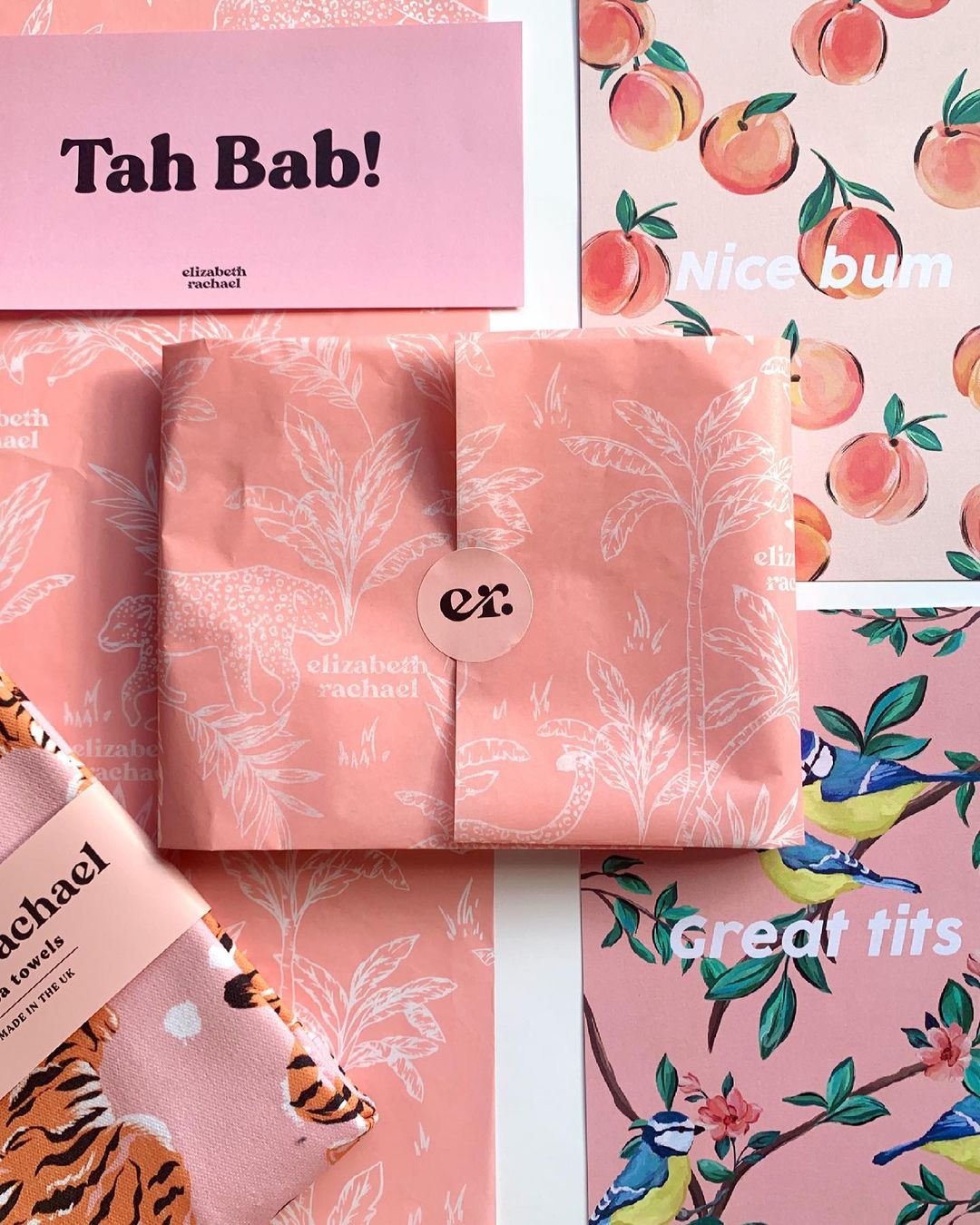@elizabethrachael
As you’re walking down the supermarket aisle or browsing online, what is it that gets you to stop? What captures your attention? What helps you recognise the products and services you love?
The answer: Brand Identity.
What is a Brand Identity?
A brand identity is made up of all the visual elements of your brand, from your logo to colours, fonts, patterns, images, and more. These things work together to distinguish you from other brands, portray your brand’s message, attract your ideal customers, and be instantly recognisable in the market.
Your brand identity is the visual expression of your brand strategy, intentionally designed to communicate your direction, solidify your position, and appeal to your audience. It turns your vision, values, and voice into tangible elements that communicate it all.
Think about McDonald's, for example. You can recognise those golden arches, the red and yellow colours, and the distinctive packaging a mile away. And those elements were all chosen for a reason: to communicate their brand, distinguish them on the street, and attract you to their delicious fries. It seems like magic, but it’s all down to the power of a strong brand identity.
Why You Need a Brand Identity 🎨
Building a brand identity isn’t just about looking good (although that’s a nice bonus!) It’s a powerful tool for establishing your brand, attracting your audience, and growing your business. With a brand strong identity, you can:
Stand Out From The Crowd
Creating a unique brand identity gives you the opportunity to surprise and delight your audience, standing out among the other options on the shelf or online. When your identity is different from others, it stops people in their tracks, starts discussions, and creates a recognizable brand that people remember.
Attract Your Audience
Every element of a brand identity has and conveys meaning. The colours, fonts, images, graphics, and logos that you choose can all work together with their inherent meanings to communicate your vision, values, and voice. This attracts the attention of your audience, appealing to the colours, images, and designs that they love, and connecting with their own vision, values and voice.
Increase Brand Recognition
One of the key goals as a brand is to be recognisable to your audience. You want your clients or customers to see your products, website, social media, or other assets and know that it’s you! They should be able to spot you on the shelf, and point you out online, knowing straight away that the content or products they’re looking at are yours. This is all done through a clear, creative, and consistent brand identity.
What Makes a Good Brand Identity 🏆
Not all brand identities are created equal. In fact, although we’re told not to judge a book by its cover, we often choose brands based on their identities, whether consciously or not.
We are attracted to brands that stand out, appeal to our interests, and say something about who we are. We choose those over brands that don’t look or feel good to us.
So when it comes to building your own brand identity, it’s about finding the right combination of elements that will appeal to your ideal audience, establish your products as the ones for them, and create a lasting impression that they recognise and remember.
A good brand identity needs to be:
- Clear: so that your audience can understand what you’re about, recognise who you are, and relate to your brand.
- Creative: so that you stand out in the market, distinguish yourself from others, and build a brand that is uniquely yours.
- Consistent: so that you continually confirm who you are, what you’re about, and what you offer in the mind of your customer.
For example: Monday’s brand identity is clear, creative, and consistent.
From first glance, you can tell what Monday does, you know whether their products appeal to you, and you can clearly recognise their brand.
Their identity is creative and stands out on the shelf amongst the many other hair care brands, appealing to a specific market of people who love the soft, minimal, feminine vibes. And their visual elements are consistently applied across their products, website, social media, and more, so you always recognise and remember their brand. It’s intentional, distinctive, and memorable.
The Elements You Need to Build a Strong Brand Identity 💪
There’s a lot that can go into a brand identity, but every brand needs the following five elements in order to establish a clear, creative, and consistent identity.
1. A Logo
First things first is a logo. This is an easily-identifiable mark that represents your brand through words, an icon, or a combination of both. It doesn’t need to be a literal depiction of what you do, but should be easily recognizable as yours.
The Shore Society creates apparel, but their logo doesn’t need to be a t-shirt! Instead, it’s a simple, recognizable mark that appeals to their target audience and can be used across all of their assets.
2. A Defined Colour palette
Colour increases recognition by up to 80%, so having a clear, consistent, and distinctive colour palette is one of the most important things you can do for your brand.
Colour also communicates a lot of meaning, so it’s a powerful tool for conveying your brand’s personality, appealing to your ideal audience, and sharing your message.
You can choose 1–3 core colours, plus some supporting neutrals that represent your brand to create a cohesive and consistent palette that you can use across all of your touchpoints.
My brand identity includes my primary colour, orange, two secondary colours, pink and blue, and two neutrals, black and cream. This colour palette keeps things cohesive, stands out online and in person, attracts the creatives in my audience, and makes my work instantly recognisable. My brand orange is one of the things I’m most known for!
3. Consistent Fonts
Max Phillips rightly explains that “type is what meaning looks like.” There are so many connotations associated with the fonts you use, so when it comes to your brand fonts, make sure to choose wisely, understand why you’re using each one and what it will convey to the reader.
Sticking to 1–2 contrasting but complimentary typefaces will keep your identity consistent & maintain your message.
This Home Day identity by Regina Studio uses two distinct typefaces that communicate the brand’s personality and create visuals that stand out.
4. Brand Imagery (Photos and Videos)
As they say, a picture is worth a thousand words, so imagery is a hugely important element of your brand identity when it comes to communicating your vision, values, and voice to your audience. Establishing a direction for your photography & videography will establish your identity and convey your brand in a clear and powerful way.
Aunty Ellen's imagery communicates so much so consistently. They describe their visual identity as modern, cute, clean, soft and minimalist, and this is clear in their photos on social media, their website, and more.
5. Graphics (Illustrations, Patterns, Icons, and Textures)
Last but not least are graphics. These elements such as illustrations, patterns, icons, and textures pull everything together to create a cohesive brand identity.
Patterns and textures can be used for packaging, social media backgrounds, website elements and more, while illustrations and icons can be used to elevate & communicate information or add personality across your brand.
These should be used in your brand colours and fit in with the overall direction of your identity.
Superette uses a selection of icons, illustrations, and graphics across their packaging, content, and website which work together to build their brand identity. According to their creative director, these elements “borrow from familiar themes and spaces such as corner stores, delis and diners, which helped to welcome our customers into their new relationship with cannabis.”
Applying these to your brand
Once you have designed each of your brand elements and have a brand identity ready to go, it’s time to apply them across your business.
You can apply these elements to your:
- Website
- Social media content
- Products
- Email marketing
- Packaging
- Signage
- Market/convention stall
- Presentation slides
- Documents
- And so much more!
Across all of these, consistency is key, so wherever you’re applying your identity, make sure you use the same colours, fonts, logos, imagery, and graphics throughout your brand.
You can make this easier by using:
- Brand guidelines: distribute these across your team, outlining what’s included in your identity, how to apply it, and what it looks like in action.
- Templates: create reusable templates for social media graphics, packaging, signage, email newsletters, signs, and more, so that you can ensure consistency no matter who’s applying your identity where.
Building a brand identity is the first step in turning your brand strategy into something tangible. It’s one of the most exciting parts of the branding process because you finally get to see your dream come to life in a way that you and your audience will love.
It’s exciting but it also has to be intentionally executed in order to be successful, so use your vision, values, and voice, understand your audience, and purposefully design an identity that resonates with both.
Enjoyed this story? Check out the other articles in our Building a Brand series.


